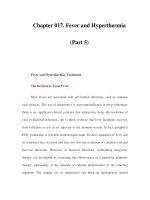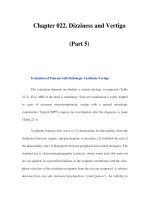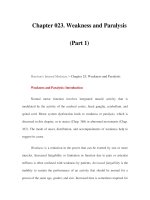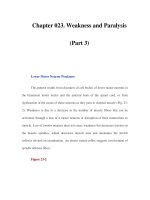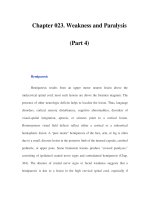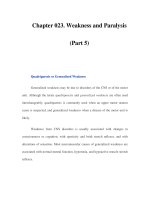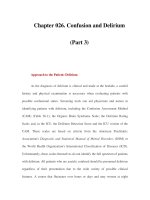Chapter 023. Weakness and Paralysis (Part 5) ppt
Bạn đang xem bản rút gọn của tài liệu. Xem và tải ngay bản đầy đủ của tài liệu tại đây (12.48 KB, 5 trang )
Chapter 023. Weakness and Paralysis
(Part 5)
Quadriparesis or Generalized Weakness
Generalized weakness may be due to disorders of the CNS or of the motor
unit. Although the terms quadriparesis and generalized weakness are often used
interchangeably, quadriparesis is commonly used when an upper motor neuron
cause is suspected, and generalized weakness when a disease of the motor unit is
likely.
Weakness from CNS disorders is usually associated with changes in
consciousness or cognition, with spasticity and brisk stretch reflexes, and with
alterations of sensation. Most neuromuscular causes of generalized weakness are
associated with normal mental function, hypotonia, and hypoactive muscle stretch
reflexes.
The major causes of intermittent weakness are listed in Table 23-2. A
patient with generalized fatigability without objective weakness may have the
chronic fatigue syndrome (Chap. 384).
Table 23-2 Causes of Episodic Generalized Weakness
1. Electrolyte disturbances, e.g., hypokalemia, hyperkalemia,
hypercalcemia, hypernatremia, hyponatremia, hypophosphatemia,
hypermagnesemia
2. Muscle disorders
a. Channelopathies (periodic paralyses)
b. Metabolic defects of muscle (impaired carbohydrate or fatty acid
utilization; abnormal mitochondrial function)
3. Neuromuscular junction disorders
a. Myasthenia gravis
b. Lambert-Eaton myasthenic syndrome
4. Central nervous system disorders
a. Transient ischemic attacks of the brainstem
b. Transient global cerebral ischemia
c. Multiple sclerosis
Acute Quadriparesis
Acute quadriparesis with onset over minutes may result from disorders of
upper motor neurons (e.g., anoxia, hypotension, brainstem or cervical cord
ischemia, trauma, and systemic metabolic abnormalities) or muscle (electrolyte
disturbances, certain inborn errors of muscle energy metabolism, toxins, or
periodic paralyses). Onset over hours to weeks may, in addition to the above, be
due to lower motor neuron disorders. Guillain-Barré syndrome (Chap. 380) is the
most common lower motor neuron weakness that progresses over days to 4 weeks;
the finding of an elevated protein level in the cerebrospinal fluid is helpful but
may be absent early in the course.
In obtunded patients, evaluation begins with a CT scan of the brain. If
upper motor neuron signs are present but the patient is alert, the initial test is
usually an MRI of the cervical cord. If weakness is lower motor neuron,
myopathic, or uncertain in origin, the clinical approach begins with blood studies
to determine the level of muscle enzymes and electrolytes and an EMG and nerve
conduction study.
Subacute or Chronic Quadriparesis
When quadriparesis due to upper motor neuron disease develops over
weeks, months, or years, the distinction between disorders of the cerebral
hemispheres, brainstem, and cervical spinal cord is usually possible clinically. An
MRI is obtained of the clinically suspected site of pathology. EMG and nerve
conduction studies help to distinguish lower motor neuron disease (which usually
presents with weakness that is most profound distally) from myopathic weakness,
which is typically proximal.
Monoparesis
This is usually due to lower motor neuron disease, with or without
associated sensory involvement. Upper motor neuron weakness occasionally
presents as a monoparesis of distal and nonantigravity muscles. Myopathic
weakness is rarely limited to one limb.
